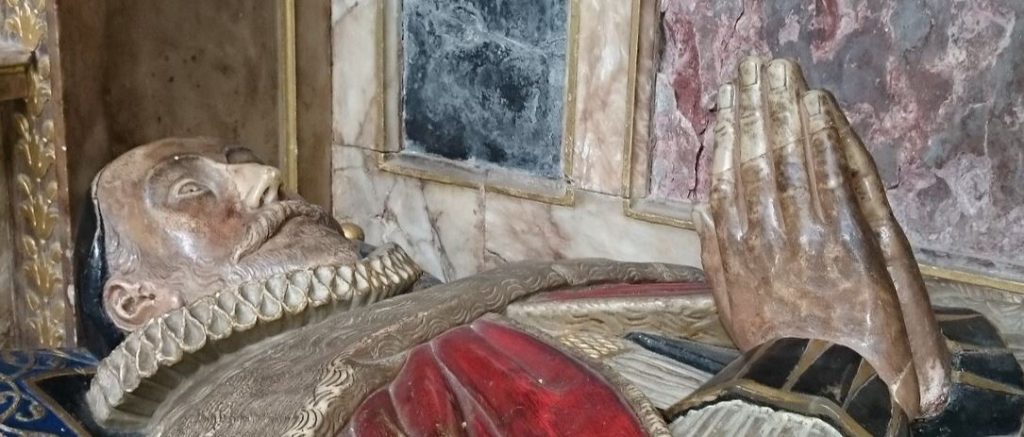Early in the Civil War, according to the royalist journalist Bruno Ryves (aka Mercurius Rusticus), the old tombs of Exeter Cathedral were subjected to a ferocious iconoclastic assault. “They strook off the heads of all the statues on all monuments in the Church, especially they deface the Bishops’ Tombs, leaving one without a head, another without a nose, one without a hand, and another without an arm.” Ryves laments this outbreak of pointless and pitiless vandalism, but also makes it the occasion for a sly joke. In mutilating the episcopal effigies, these deluded Puritans have produced a true image of the Church they desire: “a poor deformed, mangled, mutilated thing, having neither head of Prelation, nor face of Honour, nor arm, nor hand, nor finger of power.”
The joke is a good one, and perhaps justifies the fact that Ryves’ account of the desecration of the episcopal tombs is made up almost out of whole cloth. Although Exeter Cathedral undoubtedly suffered many disruptions to its fabric in the course of the Civil War and Interregnum, none of the nine episcopal effigies present at that time has lost a head or an arm. Several have indeed lost parts of their fingers and hands, but in the majority of cases this vandalism was carried out a full century before the Civil War. The zealous reforming Dean Simon Heynes, whose assaults on images provoked a formal complaint from the cathedral canons, was responsible for defacing several episcopal tombs and chapels in the 1530s and 1540s. When the Puritans entered the Cathedral a century later, their minds supposedly bent on desecration, they would have been satisfied to see that much of their work was already done.
Only one monument in the cathedral appears to have suffered significant damage in the mid-seventeenth century. This was the recently-installed polychrome effigy of Bishop Valentine Carey (d. 1626), which was indeed left “without a nose” and lost the fingertips of hands that had been joined in prayer – an assault matching Ryves’s description, but also closely echoing the practices of earlier Reformation iconoclasts. Considered in the context of its surroundings, the damage done to Carey’s effigy does not suggest an unprecedentedly ferocious assault on the image of episcopacy. Rather, it could be described as a conscientious attempt to bring this new monument into conformity with other episcopal effigies in the cathedral, such as those of Edmund Stafford and Walter Branscombe, both of which appear to have lost their noses and suffered damage to their hands at a much earlier date.

The main offense done to the episcopal tombs of Exeter in this period did not consist in defacement, but in their demotion from places of honour during the Interregnum. In 1684, John Reynolds preached a sermon in the cathedral, congratulating the bishop for “removing all marks of the late rebellion, so by restoring the Monuments of several Bishops your Predecessors to their places again, which … were thrust aside into the darkest corners of the Church and there very rudely misplaced and obscured.” It was probably in the course of “removing all marks of the late rebellion” that Bishop Carey’s lost appendages were meticulously replaced. Unlike Branscombe and Stafford, who remain disfigured to this day, Carey boasts an exquisitely crafted new nose.

Fine as the workmanship is, the sutures are clearly visible, and the bishop’s new nose and fingertips are brighter in hue than the sculpture to which they are attached, with a slight iridescence that seems almost designed to catch the eye. The result is that these repairs simultaneously erase and commemorate the iconoclasm of the Civil War. With his shiny new nose, Valentine Carey’s effigy becomes a double emblem of remembered conflict and restored community, displaying the unmistakable marks of the late rebellion in order to remind the viewer how thoroughly the marks of that rebellion have been removed.